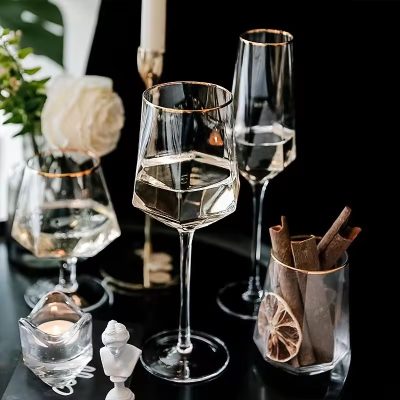Introduction: Wine tasting is a sensory journey that encompasses aroma, flavor, and texture, and the vessel from which wine is consumed plays a crucial role in shaping this experience. Wine glasses are not just functional containers; they are meticulously designed instruments that enhance the appreciation of wine. This article explores the world of wine glasses, examining their design, functionality, and profound impact on the art of wine tasting.
Craftsmanship and Design: Crafted with precision and artistry, wine glasses are designed to optimize the sensory experience of wine tasting. Each glass features a carefully shaped bowl that allows the wine to aerate, releasing its full bouquet of aromas. The thin rim ensures a smooth flow of wine onto the palate, while the elongated stem provides an elegant grip and prevents heat transfer from the hand. Crafted from fine crystal or lead-free glass, wine glasses offer exceptional clarity, allowing the wine’s color and brilliance to shine through.
Variety in Glassware: There is a diverse array of wine glasses available, each tailored to suit different wine varietals and styles. Bordeaux glasses, with their tall, broad bowl, are ideal for bold red wines, allowing ample space for aeration and showcasing the wine’s robust flavors and aromas. In contrast, Burgundy glasses feature a wider bowl and tapered rim, perfect for delicate reds with nuanced aromatics. White wine glasses typically have a narrower bowl and shorter stem, preserving the wine’s crisp acidity and delicate aromas.
Enhancing the Tasting Experience: Wine glasses serve as vessels through which the sensory journey of wine tasting unfolds. The shape and design of the glassware influence the dispersion of aromas, directing them towards the nose and enhancing the olfactory experience. As the wine coats the palate, the smooth contours of the glass accentuate its texture and mouthfeel, amplifying the interplay of flavors and complexities. With each sip, the wine reveals its character, inviting the taster on a captivating journey of discovery.
Cultural Significance and Tradition: Beyond their functional role, wine glasses hold cultural significance and tradition, symbolizing reverence for the artistry and heritage of winemaking. The ritual of pouring wine into a glass, swirling it gently, and savoring its aroma is steeped in history and respect for the craftsmanship of winemakers. Whether enjoyed in solitude as a moment of reflection or shared among friends in celebration, wine glasses evoke a sense of connection to tradition and craftsmanship, enriching the wine-drinking experience.
Conclusion: Wine glasses are not merely vessels for holding wine; they are essential tools for unlocking the sensory pleasures and complexities of wine. With their exquisite craftsmanship, versatility, and ability to enhance the tasting journey, wine glasses elevate the art of wine appreciation to new heights. Each sip taken from a wine glass is a celebration of the rich heritage and timeless allure of winemaking, a testament to the artistry and craftsmanship that have made wine a symbol of refinement and sophistication. Here’s to raising a glass – or a Bordeaux, or a Burgundy – to the enduring allure of wine and the sensory pleasures it bestows!







